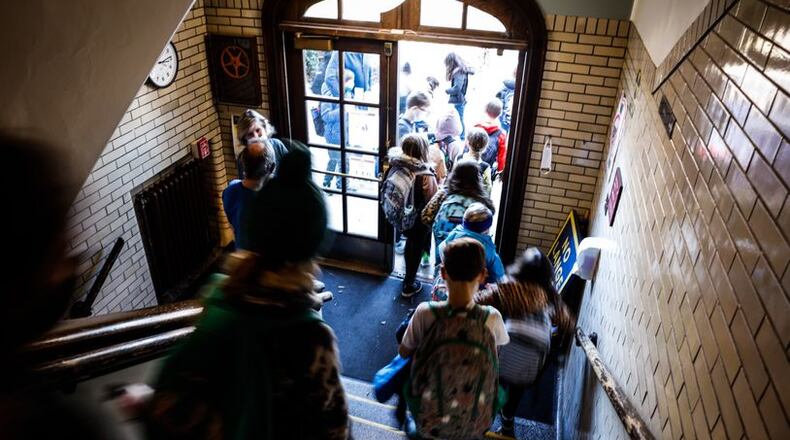That new state operating budget, which must be passed by Ohio legislators by midnight June 30, is key for some of the major challenges coming their way for the looming 2023-2024 school year.
Officials won’t know the level of state funding for operating local public school districts until the budget is finalized.
Some area school districts, such as Edgewood and Ross, saw proposed tax hikes rejected by voters in May, while others, including Fairfield and Talawanda, have publicly stated they are considering asking local residents for more tax money.
Moreover, the coming school year will be the latest in a series of years — since the onset of the COVID-19 in March 2020 — where area districts will mirror those nationwide as officials continue to try to provide and pay for academic assistance programs to help lagging students whose K-12 learning was slowed by pandemic interruptions.
Adding to concerns are the on-going developments over historically large property assessment valuations being proposed by the state and opposed by Butler County officials and others.
The challenges coming over the horizon for August’s school openings are significant, said Hamilton City Schools Superintendent Mike Holbrook.
And the unknown variables make predicting the financial futures of school systems in 2023-2024 and beyond problematic, said Holbrook.
“The major challenge facing Hamilton City Schools and most school districts throughout Ohio is the instability of state funding. The biennium budget impacts Hamilton City Schools significantly, as over 70% of the district’s budget comes from state dollars,” said Holbrook, who leads the 9,000-student city schools.
He said there is “additional uncertainty with property tax increases in Butler County (making) it a challenging time to determine future revenue.”
Regardless of the financial state of each of Butler County’s 10 public school districts, they all share an additional challenge of finding funds and personnel to also continue to try and improve the state of student mental health worsened by the pandemic’s disruptions in recent years.
Holbrook, who championed such efforts prior to COVID-19′s 2020 onset, said the need remains dire.
“Education and society are ever-changing, and the need for mental health services and additional support has never been higher in my 32 years in education.”
Funding remains a focus going into the new school year, said Adam Zink, treasurer of the 17,200-student Lakota Schools, because it fuels the engine of all key, student-oriented services.
Like many area districts, Lakota officials anticipated the so-called “Covid Cliff,” where the millions of dollars in federal and state funds that helped local districts operate during the more active pandemic years are now being phased out.
“Knowing that any programs funded through (federal relief) dollars would eventually come back into our annual budget, we have been very intentional about how we used this aid. Before implementing any spending through (federal relief), our executive leadership put plans in place to sunset certain programs,” said Zink.
But Zink — and other officials with Butler County’s most populous district — are watching closely the formulation of the pending state budget closely.
“We are carefully monitoring whether or not the biennium budget will increase state funding for Lakota. As a district that is on a guarantee, which means that Lakota continues to be funded at the fiscal year 2021 level, we are not anticipating additional unrestricted state aid in the new biennium.”
Billy Smith, superintendent of the 10,000-student Fairfield Schools, said it’s a blurry view right now for any local district officials trying to look down the road.
Earlier this year, Fairfield officials conducted a number of school board presentations for the public focusing on the need for more local tax funding.
But this month’s lead up to the unveiling of the next state budget has halted those.
“Unfortunately, there are too many moving parts or variables in play to paint a clear picture. As a result, the district is unable to move forward with some of the discussions that we would like to be having around school finance,” said Smith.
“As it stands now, the district will have to revisit those discussions in July once we have a clear picture from the state.”
Jeff Staggs, superintendent of Madison Schools, said his district is “extremely focused” on what the new Ohio budget holds in store for his rural school system.
“Funding will be a major concern for Madison Schools going into next school year. Our main concern is that the (state’s) Fair School Funding Model (local school financing) be funded fully and the inputs for expenses are at the 2022 level.” said Staggs.
Officials at the Oxford-area Talawanda Schools are keenly aware of what is at stake financially for their district.
In November 2022, voters there rejected a proposed school tax hike and Talawanda officials have since repeatedly told its school community the need for more state and local funds remains.
Talawanda will go into the 2023-2024 school year with budget cuts across the district, including no high school busing, in order to cover its projected operating budget shortfall.
“Some of the relief funds that came during the COVID-19 pandemic have dried up, and replacement funds coming from the state do not exist,” said Holli Hansel, spokeswoman for Talawanda Schools.
“Given that Talawanda, like most of our district neighbors and other districts across the state are in a financial crisis, the district is facing making many (budget) cuts during the next three years,” said Hansel.
Kelly Spivey, superintendent of Edgewood Schools, saw voters in May reject the first proposed earned income tax to help to cover some of its projected budget deficit.
Public discussions as to a next step are largely on hold until the state budget is finalized.
“On a national level, schools have seen a decrease in math and reading performance and an increase in children’s mental health concerns, as has Edgewood. This compounded by one of the largest inflation increases over the past year has only magnified district challenges since the pandemic,” said Spivey.
“School districts are having to problem-solve ways to do more with less money. This certainly puts a huge burden on educators. Many superintendents in Ohio are hopeful that the new biennium budget will alleviate some of the financial burdens on our school districts.”
Hansel said Talawanda and all districts locally and nationally “are still adjusting to a post-pandemic world. We don’t know what all of the impacts are to that yet because not enough time has passed.”
But, she added, “in many ways things are getting better, but we still have difficulties to face, financial burdens to resolve and we always are working on ways to make the best opportunities we can for our students despite these hardships.”
About the Author

